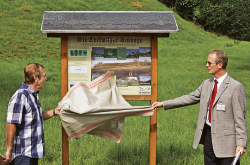WACKER is involved in a number of local projects to protect and promote biodiversity and nature conservation. Its environmental-protection efforts to conserve resources and reinstate habitat help maintain the balance of species. Burghausen’s Site Planning unit develops strategies for limiting land use.
We carefully assess the impact that site expansions may have on nature and biodiversity and – in consultation with the authorities – implement environmental mitigation programs to offset these impacts. Take the expansion of our polysilicon production facilities at Burghausen and Nünchritz, for example. For every tree felled during construction of the new polysilicon production facility on the 94-hectare Nünchritz site, we plant a new one. Working with nature conservation bodies, we have replanted just under 10 hectares of woodland. In Leckwitz, a suburb of Nünchritz, WACKER has landscaped 13 hectares to compensate for clearing a small birch wood.
Covering 232 hectares (about the same size as Munich’s historic old town), our Burghausen site borders a Natura 2000 nature reserve alongside the Salzach river. To check whether the operation of our facilities has any effect on this reserve, we monitor our air pollution levels and had an external consultant produce an immissions register for the site. The results show that emissions into the atmosphere at the site do not significantly impact the nature reserve.
A group of employees at our US site in Adrian (Michigan) has set up nesting boxes for various species of bird and maintains a 2.4-km nature trail. The site premises also feature wildflower and butterfly gardens. For its dedication to nature and wildlife conservation, the Adrian team was awarded the US Wildlife Habitat Council’s 2008 “Wildlife at WorkSM” certificate, which is valid for three years.
Siltronic’s site at Portland (Oregon, USA) is located between the Willamette River and a forested area of approximately 20 km². The City of Portland has divided this river region into nature conservation zones to provide restored habitats for flora and fauna. Part of the Siltronic plant is located near the riverbank and is suitable as a conservation zone. Siltronic therefore reached an agreement with Portland in 2010, under which Siltronic has set aside 30,000 m² of its approximately 34-hectare site for nature conservation. The area contains a portion of Doane Creek which, together with the surrounding grassland, is to be restored to its original state. The objective is to establish a restored wildlife corridor from the forest to the river and extend habitats for fish.

WACKER teamed up with pro natura Elbe-Röder (a nature conservation center based in Saxony) to provide an interpretive panel for the “Leckwitzer Schanze” hill fort. Site manager Gerd Kunkel (right) joined Tilo Jobst, director of pro natura, to unveil the panel. Installed on the Elbe Cycle Route in summer 2010, the panel explains the botanical, geological and historical importance of these impressive earthworks located near the town of Meissen. Plants such as the long-leaved speedwell, woad, crown vetch and sickleweed flourish on this dry grassland habitat, as do many butterflies and songbirds.

